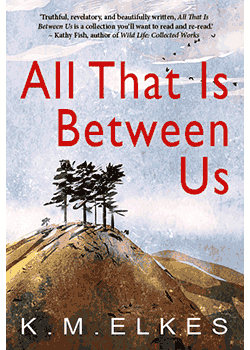
I purchased the ebook version of this book from the publisher.
Humans are strange creatures; tense with a desire for connection, yet frequently unable to recognise it until it’s too late. K.M. Elkes’ flash fiction collection All That Is Between Us is a book about connections and human frailty, what people will sacrifice to avoid being alone, and how their attempts to hold onto others are so often futile.
Elkes examines relationships through three lenses, and the book is divided as such; the connections between parents and children, the dichotomies between couples and lovers, and the transitions between friends and strangers. The stories range between uplifting and devastating, and from the very first lines the fragility and beauty of the human condition is on full display:
You could have cried at the birth. You could have kissed your wife’s cracked lips and said: ‘You did it, Tess.’
You could have been amazed at the pureness of nails, a nostril’s arc, the creases of plump hands gripping like tiny, soft-shelled crabs.
Through this opening section, stories are told by children and parents. The relationships range from the newly blooming to the newly discovered, the everyday fraught to the completely dysfunctional. What emerges, time and time again, is the sense of desire for closeness and belonging, offset by the regret of decisions made and words left unsaid.
In the second part, Ken looks at relationships between couples. The separation of ‘couples and lovers’ perfectly frames the notion that these pairings are not always filled with love; sometimes that love has faded, others it has been torn away. In some cases it was suffocated before it ever had a chance to bloom. These stories are exceptionally poignant, with a real sense of loss and longing throughout. In ‘Paper Cuts’ a man tries to revive his failing relationship:
He made two china-blue paper butterflies (used, he explained to Marianne, during Shinto weddings to represent the bride and groom) and left them on Marianne’s dressing table. He found them days later in the recycling box, one with a shopping list blackening its wings.
In the final section, Elkes ponders friendships, and the unlikely circumstances that draw people together, and send them spinning away from each other. A group of construction workers struggle with the shared grief of losing a colleague in a workplace accident; while a pair of wildlife warriors blunder through at attempt at rescue. Possibly the most emotionally resonant moment comes in ‘The Conservation of Angular Momentum’:
It was when she stretched out so he could pull her up that Jerome saw rows of silvery sickle moons scarred into her arm. His glasses began their slow descent. And he felt the slight weight of the Earth, held up in his other hand. He hesitated, just long enough for the deerstalker guy to some into the room, circle his arms around her waist, pull her away with soft words upstairs, back to the same-same point as always. In this moment, the spell cast by the story is broken, as the possibility of redemption disappears.
One of the strengths of K.M. Elkes’ writing is his understanding of exactly when to arrive and leave in a story. There is always movement, even in the shortest of pieces; characters come to the end changed somehow, whether internally or externally. This can be challenging, especially when working in very short forms, but Ken does it admirably. He is able to elicit strong emotional reactions with relatively few words. In ‘Jennifer’s Piano’ he deftly covers an extensive period, showing the passage of time through a series of events and stepping away at just the right, gutwrenching moment.
Elkes uses small details effectively to draw the reader into the story, and weave a narrative around a moment. Whether it’s ‘the hiss of sprinklers watering perfect lawns’, ‘stitches like sewn-up lips’, or ‘confetti rice hard as hailstones’, these choices root the reader in the scene and create a mood around the events, guiding interpretation and layering meaning beautifully.
All That Is Between Us follows what it means to be human, and to feel, from childhood to old age. There is a diversity here that appeals, in voice and character; there is always someone to cheer for, and to grieve with. From the heartwarming moments of realisation as bonds strengthen and beauty is discovered, to the quiet tragedy of ended relationships and disconnections, this is a brilliant example of craft in flash fiction which will bring the reader back for second servings, each one more subtle and complex in flavour than before.
All That Is Between Us is available now from Ad Hoc Fiction.
